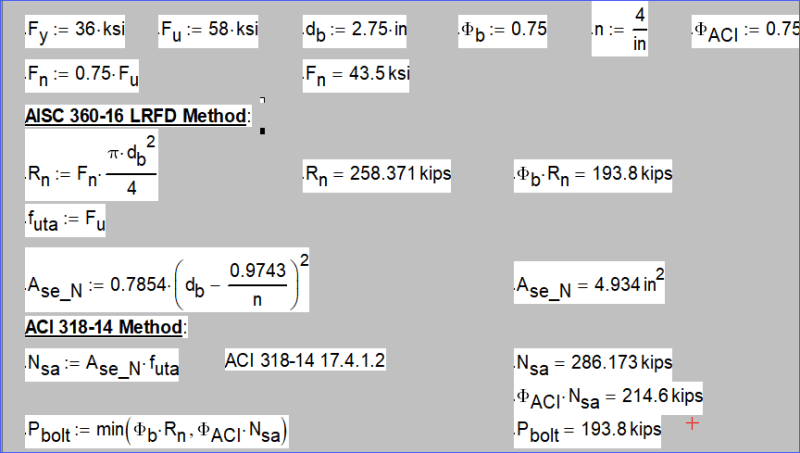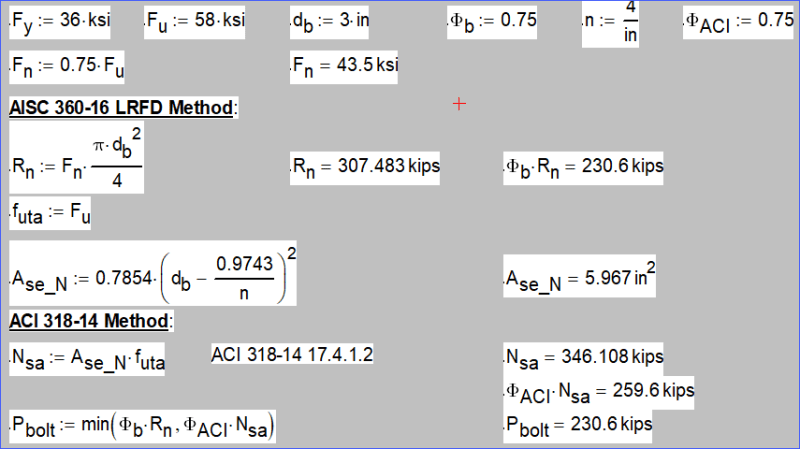structure_engineer
Structural
- May 5, 2022
- 46
Dear Fellow Civil Structural Engineers,
I have to design a foundation for a tall vertical vessels. The anchor bolts designed by the Mechanical Engineers or Vessel Engineers are 2 3/4" diameter F1554 anchor bolts. I am new to this material and thus I need some help to verify if the calculations I did on the anchor bolts capacity are correct and can be used.
AISC Method: =================================================================
Using Section J3.7:
Rn = Fn .Ab
For Ultimate Strength:
where Fn =0.75Fu and for LRFD phi = 0.75
Thus, Rn = phi 0.75Fu Ab = 0.75(0.75)58(pi*2.75^2)/4 = 0.75(0.75)58(5.94) = 193.8 kips
For Allowable Stress Design:
Pa = 0.5(0.75)Ab(Fu) Pg 77 of Steel Design by Segui 5th ed
Pa = 0.5(0.75)(pi*2.75^2/4)(58) = 129.1 kips
As a comparison, the company standard table shows a capacity of 107 kips (Allowable)
The value of 107 kips is obtained as the following:
Rn = Fn Ab Eq. J3-1
Fn = 0.75 Fu
Rn = (0.75 * 58*4.93)/2 (Net tensile area)
Rn = 107.2 kips
I am not sure which is the correct value, the 129.1 kips or the 107.2 kips. I am leaning towards the 129.1 kips as that is based on academic research. The 107.2 kips value is more like based on internal colleague recommendations.
ACI Method: ===================================================================
phi*Nsa = phi*Ase,N *(futa) = 0.75*4.934 *(58 ksi)
Because F1554 Grade 36 is a ductile material, ACI 318-11 D.4.3 says phi = 0.75
phi Nsa = 0.75*4.93*48 = 214.5 kips
Thus, bolt capacity will be the minimum of 193.8 kips or 214.5 kips, for which 193.8 kips governs.
If some of you help to verify the calculations, I could furnish a tabulation of the anchor bolt capacities for the various diameters on here for everyone to use. After all, we need to combine our effort for the good of engineering community for which I believe is one of the purpose of this website. Thank you so much for your attention and effort.
I have to design a foundation for a tall vertical vessels. The anchor bolts designed by the Mechanical Engineers or Vessel Engineers are 2 3/4" diameter F1554 anchor bolts. I am new to this material and thus I need some help to verify if the calculations I did on the anchor bolts capacity are correct and can be used.
AISC Method: =================================================================
Using Section J3.7:
Rn = Fn .Ab
For Ultimate Strength:
where Fn =0.75Fu and for LRFD phi = 0.75
Thus, Rn = phi 0.75Fu Ab = 0.75(0.75)58(pi*2.75^2)/4 = 0.75(0.75)58(5.94) = 193.8 kips
For Allowable Stress Design:
Pa = 0.5(0.75)Ab(Fu) Pg 77 of Steel Design by Segui 5th ed
Pa = 0.5(0.75)(pi*2.75^2/4)(58) = 129.1 kips
As a comparison, the company standard table shows a capacity of 107 kips (Allowable)
The value of 107 kips is obtained as the following:
Rn = Fn Ab Eq. J3-1
Fn = 0.75 Fu
Rn = (0.75 * 58*4.93)/2 (Net tensile area)
Rn = 107.2 kips
I am not sure which is the correct value, the 129.1 kips or the 107.2 kips. I am leaning towards the 129.1 kips as that is based on academic research. The 107.2 kips value is more like based on internal colleague recommendations.
ACI Method: ===================================================================
phi*Nsa = phi*Ase,N *(futa) = 0.75*4.934 *(58 ksi)
Because F1554 Grade 36 is a ductile material, ACI 318-11 D.4.3 says phi = 0.75
phi Nsa = 0.75*4.93*48 = 214.5 kips
Thus, bolt capacity will be the minimum of 193.8 kips or 214.5 kips, for which 193.8 kips governs.
If some of you help to verify the calculations, I could furnish a tabulation of the anchor bolt capacities for the various diameters on here for everyone to use. After all, we need to combine our effort for the good of engineering community for which I believe is one of the purpose of this website. Thank you so much for your attention and effort.

![[thumbsup2] [thumbsup2] [thumbsup2]](/data/assets/smilies/thumbsup2.gif)



![[wink] [wink] [wink]](/data/assets/smilies/wink.gif) , through automation and exchange of ideas. Keep on trucking guys.
, through automation and exchange of ideas. Keep on trucking guys.![[cheers] [cheers] [cheers]](/data/assets/smilies/cheers.gif)

